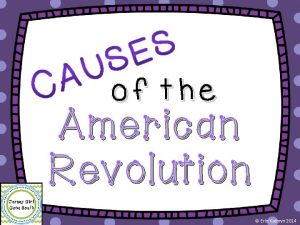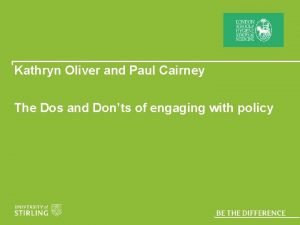Erin Kathryn 2018 s e s Cau GREAT


















- Slides: 18

© Erin Kathryn 2018 s e s Cau GREAT DEPRESSION e h t of Power. Point & Notes Set

© Erin Kathryn 2018 What was the Great Depression? • The Great Depression occurred in the 1930 s. • During this time, the economy was at an all time low. • The economy is the system of how money is made and used or spent. • A region's economy is connected with things like how many goods and services are produced and how much money people can spend on these things.

© Erin Kathryn 2018 What was the Great Depression? • As a result of the economy being in a crisis, many people lost their jobs. • People were not able to provide for themselves and their families. • Many people were hungry and homeless. • The Great Depression started in the United States, but became worldwide.

© Erin Kathryn 2018 How did this happen? • The Great Depression was caused by a series of factors that led to this extended period of hardship. • There was not one particular event that led to the Great Depression. • Let’s take a look at some of those factors.

© Erin Kathryn 2018 Stock Market Crash of 1929 • The Stock Market Crash of 1929 marks the start of the Great Depression. • The stock market is where stocks and bonds are traded (bought and sold). • Stocks are units of ownership in a company. • In the 1920 s, stocks became worth more than their actual value of the company.

© Erin Kathryn 2018 Stock Market Crash of 1929 • Many people were buying stocks on credit from the bank. • Eventually, the market slowed and the stock values began to fall. • People panicked and started to sell their stocks.

© Erin Kathryn 2018 Black Tuesday • On October 29, 1929, stock prices plummeted. • Around $15 billion dollars was lost in 1 day. • The crash lasted 4 days. • Millions of people lost money in the stock market crash. • Some lost their entire savings, their houses, cars, businesses, etc.

© Erin Kathryn 2018 The Drought • The farming industry had been struggling before the Great Depression. • Farmers were having trouble making a profit because new machinery was able to mass produce crops, which caused the price of crops to drop.

© Erin Kathryn 2018 The Dust Bowl • In the Midwest, a drought began that would last until 1939. • As a result, farmers could no longer afford to keep their farms. • Many moved to California in hopes of finding work.

© Erin Kathryn 2018 Overproduction • In the 1920 s, the economy was booming. • Many companies built new factories and hired workers. • After the stock market crashed, more goods were being produced than people could afford to buy. • Many people were hesitant to spend money. • Factories slowed production and laid off workers. • Many companies went out of business.

© Erin Kathryn 2018 Too Much Debt • When the economy was doing well in the 1920 s, there were many new products on the market, such as automobiles, refrigerators, radios, and washing machines. • For the first time, people were able to buy bigger items on credit. Credit is a loan.

© Erin Kathryn 2018 Too Much Debt • When the stock market crashed, people were no longer able to pay back their loans. • As a result, they lost their homes, businesses, farms, etc.

© Erin Kathryn 2018 Bank System Failed • In the 1930 s, if a bank closed, the accounts and money people had with that bank were lost. • After the stock market crashed, people feared that their banks would close and that they would lose all their money. • People removed their savings from the bank.

© Erin Kathryn 2018 Bank System Failed • Banks need cash to operate properly and many banks did not keep much cash in their building. • Banks applied to the Federal Reserve Banks for cash loans, but the requests were not often granted. • As a result, many banks began to fail.

© Erin Kathryn 2018 Bank System Failed • In the beginning years of the Great Depression, over 10, 000 banks closed their doors. • This impacted civilians greatly. • People lost their life savings. • Many people went from being rich to having nothing. • The U. S government did very little to help banks stay open.

© Erin Kathryn 2018 World Trade • While the Great Depression started in the United States, the entire world economy was struggling during this time. • The United States had loaned money to its allies during World War I. • These countries could not pay back the United States because they were struggling, too.

© Erin Kathryn 2018 Smoot-Hawley Act • In 1930, President Hoover signed the Smoot-Hawley Act. • This act raised taxes on imported goods. • The idea was to make foreign goods more expensive than American goods. • President Hoover wanted Americans to buy American goods to increase sales and job opportunities.

© Erin Kathryn 2018 World Trade • However, this meant an increased import tax for other countries buying American goods. • This angered other countries so much that they stopped buying American goods. • This led to decreased international trade and more American workers being laid off.
 Erin kathryn 2014
Erin kathryn 2014 Erin kathryn 2017
Erin kathryn 2017 Erin kathryn
Erin kathryn Erin kathryn 2016
Erin kathryn 2016 Cấu tạo màng lọc cầu thận
Cấu tạo màng lọc cầu thận đặc điểm hình thức của câu cầu khiến
đặc điểm hình thức của câu cầu khiến Seekers great bear lake
Seekers great bear lake B a f c j e
B a f c j e Capacool
Capacool Kathryn waddington
Kathryn waddington Kathryn singleton
Kathryn singleton Impetigo fun facts
Impetigo fun facts Kathryn spilios
Kathryn spilios Kathryn e. barnard metaparadigmas
Kathryn e. barnard metaparadigmas Paul cairney
Paul cairney Kathryn coombes md
Kathryn coombes md Inr levels
Inr levels Dr kathryn boyd
Dr kathryn boyd Kathryn e barnard
Kathryn e barnard
































